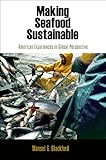Making Seafood Sustainable : American Experiences in Global Perspective / Mansel G. Blackford.
Material type: TextSeries: American Business, Politics, and SocietyPublisher: Philadelphia : University of Pennsylvania Press, [2011]Copyright date: ©2012Description: 1 online resource (288 p.) : 20 illusContent type:
TextSeries: American Business, Politics, and SocietyPublisher: Philadelphia : University of Pennsylvania Press, [2011]Copyright date: ©2012Description: 1 online resource (288 p.) : 20 illusContent type: - 9780812243932
- 9780812206272
- 639.8 23
- SH136.S88 B53 2012eb
- online - DeGruyter
- Issued also in print.
| Item type | Current library | Call number | URL | Status | Notes | Barcode | |
|---|---|---|---|---|---|---|---|
 eBook
eBook
|
Biblioteca "Angelicum" Pont. Univ. S.Tommaso d'Aquino Nuvola online | online - DeGruyter (Browse shelf(Opens below)) | Online access | Not for loan (Accesso limitato) | Accesso per gli utenti autorizzati / Access for authorized users | (dgr)9780812206272 |
Frontmatter -- CONTENTS -- Preface -- Introduction -- PART I. Government Regulation -- 1. Global Over-Fishing and New Regulatory Regimes -- 2. Successes and Failures in the Regulation of American Fisheries -- Part II. The Industry -- 3. Salmon Fishing: From Open Access to Limited Entry -- 4. King Crabbing: Catch Limits and Price Setting -- 5. Bottom Fishing: Quotas and Sustainability -- Part III. Changing the Food Chain -- 6. The Companies: Controlling Food Chains -- 7. Reaching Consumers: From Processing to Retailing -- Conclusion -- Appendix: The Top-Ten U.S. Seafood Suppliers, 1999-2006, with Sales -- List of Abbreviations -- Notes -- Bibliographic Essay -- Index -- Acknowledgments
restricted access online access with authorization star
http://purl.org/coar/access_right/c_16ec
In the spring of 2007, National Geographic warned, "The oceans are in deep blue trouble. From the northernmost reaches of the Greenland Sea to the swirl of the Antarctic Circle, we are gutting our seas of fish." There were legitimate grounds for concern. After increasing more than fourfold between 1950 and 1994, the global wild fish catch reached a plateau and stagnated despite exponential growth in the fishing industry. As numerous scientific reports showed, many fish stocks around the world collapsed, creating a genuine global overfishing crisis.Making Seafood Sustainable analyzes the ramifications of overfishing for the United States by investigating how fishers, seafood processors, retailers, government officials, and others have worked together to respond to the crisis. Historian Mansel G. Blackford examines how these players took steps to make fishing in some American waters, especially in Alaskan waters, sustainable. Critical to these efforts, Blackford argues, has been government and industry collaboration in formulating and enforcing regulations. What can be learned from these successful experiences? Are they applicable elsewhere? What are the drawbacks? Making Seafood Sustainable addresses these questions and suggests that sustainable seafood management can be made to work. The economic and social costs incurred in achieving sustainable resource usage are significant, but there are ways to mitigate them. More broadly, this study illustrates ways to manage commonly held natural resources around the world-land, water, oil, and so on-in sustainable ways.
Issued also in print.
Mode of access: Internet via World Wide Web.
In English.
Description based on online resource; title from PDF title page (publisher's Web site, viewed 24. Apr 2022)


